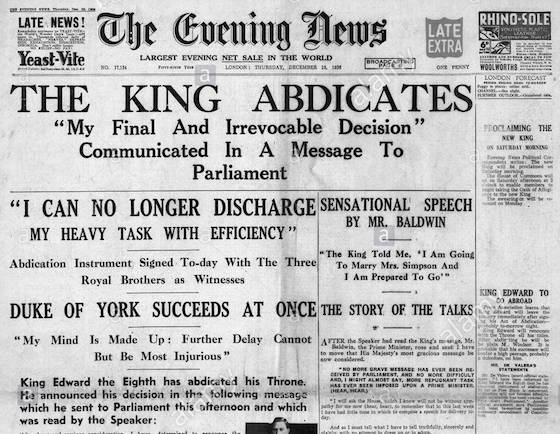Sunday, December 11 it will be 80 years since King Edward VIII shocked the world by announcing his abdication in order to marry Wallis Simpson. Constitutional Law expert Neil Parpworth considers its impact:

The 11th December 2016 marks the 80th anniversary of the passage of His Majesty’s Declaration of Abdication Act 1936. The Act consists of a mere two sections and a schedule containing the Instrument of Abdication, signed by the then King, Edward VIII, and witnessed by his three brothers, the Dukes of York, Gloucester and Kent.
The text of the Instrument states:
“I, Edward the Eighth, of Great Britain, Ireland, and the British Dominions beyond the Seas, King, Emperor of India, do hereby declare My irrevocable determination to renounce the Throne for Myself and for My descendants, and My desire that effect should be given to this Instrument of Abdication immediately”.
The Bill which became the Act completed all of its parliamentary stages in a day. It is therefore a good example of how laws can be made very swiftly when the occasion demands it. It also confirms how important constitutional reforms can be achieved through the simple expedient of law made by Parliament.
Unlike most Acts, the 1936 Act took immediate legal effect. This was necessary in order to ensure the change in the line of the succession to the throne brought about by the King’s insistence that he be allowed to marry Mrs Wallace Simpson, a twice divorced American national, and his government’s refusal to accept that she be allowed to become Queen as a result of the marriage. The possibility of a morganatic marriage, whereby
Mrs Simpson would have been accorded a courteously title and any children from the union would not have featured in the line of succession, had been suggested and rejected. Accordingly, by virtue of s.1(1) of the 1936 Act, Edward VIII ceased to be King and there was a demise of the Crown to his brother, the Duke of York, who duly succeeded to “all the rights, privileges, and dignities thereunto belonging”.
The 1936 Act also addressed two further matters. Thus in s.1(2) it was made clear that by abdicating, Edward VIII was not only giving up his own right to the throne but also the rights of succession of any of his issue and of the descendants of that issue. By granting the Bill Royal Assent, the King therefore agreed to the removal of himself and his heirs from the line of succession. As it turned out, of course, the Duke and Duchess of Windsor’s marriage was childless. Accordingly, the only person to whom s.1(2) ever applied was the former King himself. Since his death in May 1972, the provision has become redundant. Nevertheless, in 1936, it was necessary for the matter to be dealt with so as to avoid any future disputes regarding claims to the throne.

At the time that the 1936 Act was passed, the marriage between the King and Mrs Simpson had of course not yet taken place. Indeed her divorce from Ernest Simpson had only been finalised in late October of the same year. Despite her own conduct, it was in fact Mrs Simpson who sued for divorce before the Ipswich Assizes in Simpson v Simpson on the grounds of her husband’s adultery. The King did not feature in the proceedings, unlike his grandfather, King Edward VII, who as Prince of Wales appeared in court as a person alleged to have had an affair with a woman being divorced by her husband.
Section 1(3) of the 1936 Act made the Royal Marriages Act 1772 unapplicable in relation to the King, his issue, and the descendants of that issue. In other words, therefore, he was absolved from the need to seek the consent of the new King, his brother George VI, prior to marrying Mrs Simpson. That requirement, which applied to all descendants of George II, was complied with in respect of royal marriages both before and after the abdication crisis. The reach of s.1 of the 1772 Act was considerable in that many persons are descended from George II, often without even knowing that this is the case. In modern times, the Act was therefore criticised for being absurd and nonsensical. It was recently repealed by the Succession to the Crown Act 2013. Whilst that Act retains the requirement of monarch’s consent for royal marriages, it limits its application to royal heirs who occupy a position which is sixth or less in the line of succession to the throne (see s.3(1)).
A final point to note about the date, 11th December, is that it also marks the anniversary of the flight of James II from Whitehall in 1688 which was one of the final acts of what has become known as the ‘Glorious Revolution’. Like the abdication crisis nearly 250 years later, the events of 1688 saw a change in the line of the royal succession. They also led to the emergence of the constitutional monarchy which had such an important impact upon how the abdication crisis was dealt with.
Thus when the former King addressed the Empire the day after his abdication in a radio broadcast from Windsor Castle, although it is often recalled that he informed his listeners that he had “found it impossible to carry the heavy burden of responsibility and to discharge my duties as King as I would wish to do without the help and support of the woman I love”, what is equally often overlooked is that these remarks were preceded by the observation that: “I have never wanted to withhold anything, but until now it has been not constitutionally possible for me to speak”.
Posted on Thursday 8 December 2016